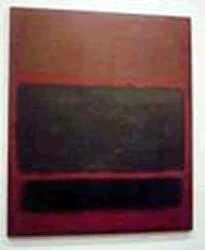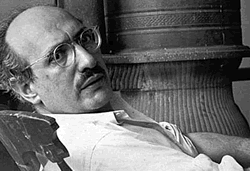Mark Rothko
From Wikipedia, the free encyclopedia

Mark Rothko's painting 1957 # 20 (1957)
Mark Rothko (September 25, 1903 – February 25, 1970) was a Latvian-born American Jewish painter who is often classified as an abstract expressionist , although he vociferously denied being an abstract painter.
He was born Marcus Rothkowitz in Daugavpils, Latvia (then part of the Russian Empire) and emigrated to Portland, Oregon in 1913. He attended Lincoln High School in Portland, and then Yale University but only for a year.
[edit]
Artwork
Among the founders of the New York School, his work concentrated on basic emotions, often filling the canvas with very few, but intense colours, using little immediately-apparent detail. In this respect, he can also be considered to presage the Color Field painters, such as Helen Frankenthaler. However, "Rothko repeatedly protested, 'I'm not interested in color' and 'I'm not a colorist.' Color, he explained, was nothing more than an 'instrument' for expressing something larger: the all important 'subjects' of his pictures" (Chave 1989).
Although respected by other artists, Rothko remained in relative obscurity until 1960, supporting himself by teaching art.

Rothko's Homage to Matisse (1953) which sold for a record $22.5 million
In 1958, Rothko was commissioned by architect Philip Johnson to paint a series of murals for the Four Seasons restaurant in the Seagram Building in New York. This substantial project was completed in late 1959 . Ultimately, Rothko was not happy having his paintings as the backdrop to gourmet dining as he felt their intensity and contemplative qualities would not suit such surroundings. Having a high regard for the Tate Britain Gallery in London, he gave the set of nine of the maroon and black works to the gallery, where they were on permanent display in an intimate installation using subdued lighting designed by Rothko. The paintings arrived at the Tate Gallery on the same day as the news of Rothko's death. Since the building of the Tate Modern further along the river, they have been moved and featured in a similarly designed gallery set aside solely for Rothko. The subdued lighting and intensity of the paintings create a contemplative atmosphere, allowing visitors to view the works in the way Rothko would have wished.
In 1967, Rothko again collaborated with Johnson on a church in Houston, Texas, contributing 14 related works in an installation setting. The church has subsequently become known as "The Rothko Chapel ". Numerous other works are scattered in museums throughout the world.
Rothko, along with other nonrepresentational painters, is alleged to have been favored by the CIA through arts institutions during the 1950s. The support was part of a Cold War campaign to steer global intellectual culture of both left and right away from Communism, on the principle that it would stand little chance of becoming political Agitprop, in contrast to American representational fine art of the time which, descended from arts of the Great Depression, New Deal economic reconstruction, and World War II, frequently had overt social or political agendas. The allegations are controversial in hindsight, but for the implications the campaign has on global intellectual culture [1], rather than for the quality of the research [2].
[edit]
Suicide and legacy
After a long struggle with depression, Rothko committed suicide by cutting his wrists in his New York studio on February 25, 1970. Additionally the settlement of his estate became the subject of the famous Rothko Case.
In early November, 2005, Rothko's 1953 oil on canvas painting, "Homage to Matisse," broke the record selling price of any post-war painting at US $22.5 million dollars.
A previously unpublished manuscript by Rothko about his philosophies on art, entitled The Artist's Reality, has been edited by his son, Christopher Rothko, and is to be issued by Yale University Press in 2006. [3]
[edit]
Quotations
"I am not an abstract painter. I am not interested in the relationship between form and colour. The only thing I care about is the _expression of man's basic emotions: tragedy, ecstacy, destiny."
"Pictures must be miraculous."
References
* Chave, Anne. "Mark Rothko, 1903-1970: A Retrospective". New Haven: Yale University Press, 1989.
[edit]
External links
* National Gallery web feature on Mark Rothko includes an overview of Rothko's career, numerous examples of his art, a biography of the artist
* Rothko Syracuse, NY based band inspired by Mark Rothko's work
* [4] A chapel in Houston Texas dedicated to Rothko paintings and non-denominational worship
* Mark Rothko's Gravesite
Retrieved from "http://en.wikipedia.org/wiki/Mark_Rothko"
One of the preeminent artists of his generation, Mark Rothko is closely identified with the New York School, a circle of painters that emerged during the 1940s as a new collective voice in American art. During a career that spanned five decades, he created a new and impassioned form of abstract painting. Rothko's work is characterized by rigorous attention to formal elements such as color, shape, balance, depth, composition, and scale; yet, he refused to consider his paintings solely in these terms. He explained:
It is a widely accepted notion among painters that it does not matter what one paints as long as it is well painted. This is the essence of academicism. There is no such thing as good painting about nothing.
